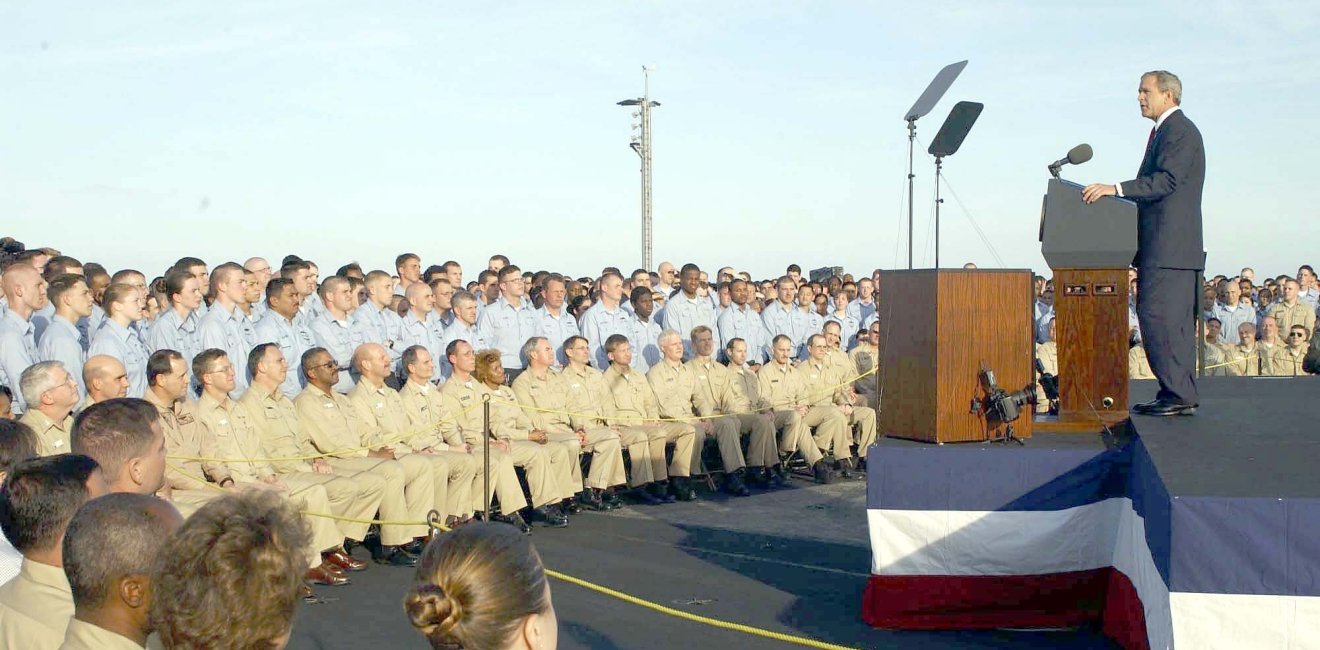Iraq 2003 and Iraq 2020: Different Countries in a Different Region
The United States is struggling to find its role in Iraq. It tried to leave, but got pulled back in. With Iranian influence on the rise, getting out comes with big sacrifices.
The United States is struggling to find its role in Iraq. It tried to leave, but got pulled back in. With Iranian influence on the rise, getting out comes with big sacrifices.

When the Bush administration went to war in Iraq, the world was a very different place from what it is today. The United States could bask in the assumption of being the world’s only superpower, with unparalleled reach of both hard and soft power. It could dream that democracy was the common destiny of all countries, and that the United States knew how to support democratic transitions and more broadly the building of nations. The Soviet Union no longer existed and Russia was not a player in the Middle East. The Middle East itself, despite its long-standing problems of poor governance and autocratic leadership, appeared stable. To be sure, the United States did not go to war in Iraq to build a democracy. The motivations were complex and had a lot more to do with national interest, as perceived by the Bush administration, and the power plays of various personalities, but the context made it easier for Bush to justify his decision.
Seventeen years later, the world looks quite different and the Middle East in particular has transformed radically. The unipolar moment turned out to be just a blip. A three-way contest for power is now playing out between the United States, Russia and China, a new trilateral cold war where the rules of the game, once well understood by both the United States and the Soviet Union, are vague. Russia has become a major player in the Middle East and appears determined to grow its influence (China so far has limited itself to purchasing oil and building infrastructure). The United States is uncertain about its role in the region, torn between the assumption that it must retain its historical hegemony and the desire to get out of a quagmire and bring the troops home. Complicating the situation, regional actors – above all Iran and Turkey – are pursuing their own policies in the neighborhood, often at odds with United States interests.
The United States is uncertain about its role in the region, torn between the assumption that it must retain its historical hegemony and the desire to get out of a quagmire and bring the troops home.
The US invasion of Iraq was certainly not the only reason for this transformation but was an important part of it. How the United States decides to act in this new environment will be equally consequential.
US. intervention upended Iraq, which under Saddam Hussein was more stable than it had ever been in its short history. Stability came at a high price, but at least the country was predictable. Tensions between ethnic and sectarian groups—Arab and Kurds, Shias and Sunnis—were high but also under control. After the 1991 Gulf war, Kurds had pulled away from Baghdad and gained de facto autonomy under the no-fly zone imposed by the United States, although they continued to fight among themselves. On the other hand, the Shia revolt against Saddam Hussein had fizzled in the absence of clear goals, unity or any international support.
After 2003, both the domestic politics of Iraq and regional relations were severely altered. As the election-based political system the United States brought to Iraq enhanced the power of Shias, the largest population group, Iran’s influence also mounted. During the 1980-88 Iran-Iraq war, Tehran had started inserting itself into the domestic politics of Iraq by helping set up Shia militias and providing shelter for Shia political parties. The dismantling of the Saddam Hussein regime provided Tehran with a golden opportunity to revive its efforts. The United States, the Gulf countries lamented constantly, “served Iraq to Iran on a silver platter.” Within three years of the invasion, the level of sectarian fighting forced the United States to send tens of thousands more troops to Iraq, an operation that proved highly successful, but only in the short run.
As the election-based political system the United States brought to Iraq enhanced the power of Shias, the largest population group, Iran’s influence also mounted.
In 2010, the United States withdrew all troops from Iraq, having failed to reach a Status of Forces Agreement with Baghdad. By 2014, the Islamic State of Iraq and al-Sham (ISIS), had occupied more than one third of the country. In response, the number and power of Shia militia, many backed and funded by Iran, skyrocketed. The sectarian divide became deeper than ever. The government in Baghdad found it increasingly difficult to maintain good relations with both Washington and Tehran. And the Sunni states in the Gulf essentially gave up on Iraq, seeing it as a vassal of Iran.
The crisis in Syria that started in 2011 added more complications. It started as a domestic affair, a conflict between the government of President Bashar al-Assad and protesters very similar to those unfolding elsewhere in the Arab world at the time. But the conflict soon devolved into civil war, eventually pulling in, directly or indirectly, other countries. Russia and Iran intervened to help keep Bashar al-Assad in power. The United States intervened to support the Syrian Kurds fighting against ISIS. Turkey intervened to prevent the Syrian Kurds from controlling the entire border region.
In the increasingly unstable situation, the United States, after setting major changes in motion, decided to minimize its role. Both the Obama and the Trump administrations pursued that goal, and the Obama administration, as mentioned, went so far as to withdraw all troops. But the emergence of ISIS frustrated plans for the United States to extricate itself from the region. In Iraq, US troops were sent back to train the Iraqi military, provide it with air cover, and support it in the fight against ISIS in general. A war justified originally as an intervention against a dictator and to build a democratic nation was reduced to a facet of the war on terrorism. But in the increasingly complicated situation in the region, even the defeat of ISIS was not enough for the United States to withdraw once more: the Iranian presence was stronger than ever, and leaving Iraq meant surrendering it to Iran, an enemy country from the point of view of the Trump administration.
A war justified originally as an intervention against a dictator and to build a democratic nation was reduced to a facet of the war on terrorism.
The emergence of ISIS also pulled an extremely reluctant United States into becoming more involved in Syria. Intervention was indirect, with only a small number of American troops deployed to support the Syrian Kurds, for whom defeating ISIS was a means to maintain the autonomy of the region they had carved in Northwest Syria. Even such limited involvement is proving extremely difficult to terminate. It would mean giving a free rein to al-Assad, supported by Russia and Iran, and to Turkey, which is intervening in Syria in pursuit of its own anti-Kurd policy at home and abroad. Despite President Trump’s determination to get out of Syria, others in the administration have fought against it.
US intervention in Iraq started in a supposedly unipolar world as a mission to fight the proliferation of weapons of mass destruction and depose a dictator. It unleashed a series of consequences, mostly unintended although not necessarily unpredictable, that together with the crisis in Syria have given rise to a situation that bears no resemblance to the relatively simple one prevailing in 2003. Seventeen years later, United States is still fighting in Iraq, but it is now a different fight in a different world.
The views expressed in this article are those of the author and do not reflect an official position of the Wilson Center.


The Wilson Center’s Middle East Program serves as a crucial resource for the policymaking community and beyond, providing analyses and research that helps inform US foreign policymaking, stimulates public debate, and expands knowledge about issues in the wider Middle East and North Africa (MENA) region. Read more




